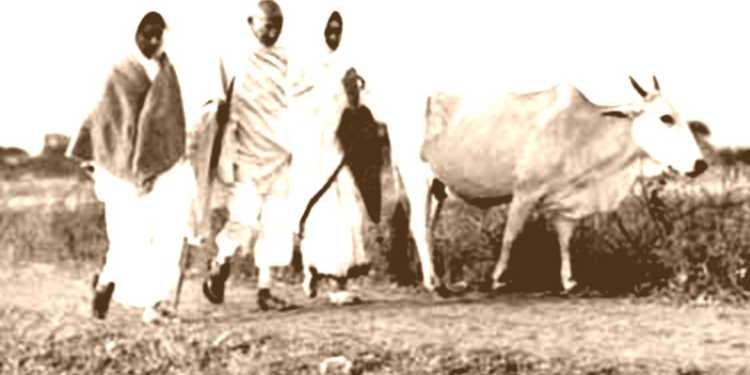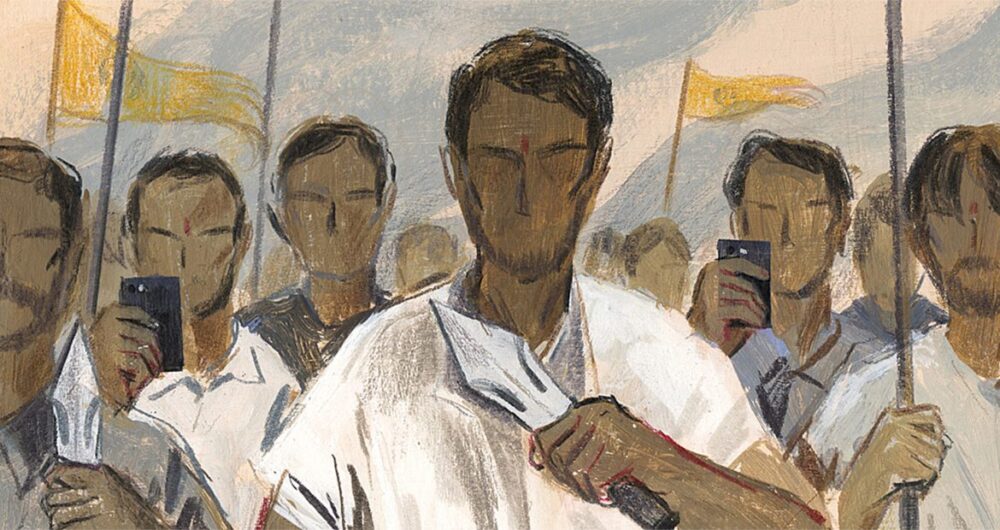In the last three instalments of the essay series Decoding The Communal Fallacies Between The Two Identities, I have tried to counter the major misgivings that have engulfed the minds of the gullible Hindu. This part of the essay series deals with the most quarrellous gorge between the two cultures. Time and again, leaders from both communities have used this issue in a bombastic way to propel their deceitful agendas. And now, this has become the most significant bone of contention between the two identities.
You can also read the earlier parts of this essay series to understand how the communal schism between the two communities is widened through the use of perverse narratives in:
Decoding The Communal Fallacies Between The Two Identities- I
Decoding The Communal Fallacies Between The Two Identities-II
Decoding The Communal Fallacies Between The Two Identities-III
The next most prominent issue that urges a radical Hindu to denunciate the Muslim culture is based upon their dietary habits. The Hindu mythology reveres Cows on the pretext of the Sanskrit epic Mahabharata which mentions: “Once when there was a great famine, King Prithu took up his bow and arrow and pursued the Earth to force her to yield nourishment for his people. The Earth assumed the form of a Cow and begged him to spare her life; she then allowed him to milk her for all that the people needed.”
The belief that enrages the common Hindus is that, despite the acknowledgement about the Holy Status of Cow for the Hindu’s, the Muslims kill them and eat them because of their intent to humiliate and downgrade the religious sentiments of Hindus.
Let us examine the veracity of this bone of contention as to understand if the denunciation is just or not?
The ancient Indian history of Cows:
In the time of the oldest Vedic text, Rig Veda (c. 1500 B.C), like most cattle-breeding cultures, cow meat was consumed. Generally, the Vedic Indians ate the castrated steers. Still, during rituals or when welcoming a guest or a person of high status, they would eat the female of the species as well.
In the third century B.C., the ancient text of rituals known as Brahmanas (c. 900 B.C.) and other texts that imparted the knowledge of religious duties(dharma), says, on the arrival of guests, bull or Cow should be killed to be eaten.
The modern History of Cows:
The Gandhian-era was particularly a significant phase in the status of cows in India. Gandhi attempted to make vegetarianism, a central tenet of Hinduism. He saw kind Mother Earth in the image of Cows, the one milked by the King Prithu, to symbolize his fictional Indian nation with an attitude of tolerance and non-violence. His ideas of cow protection was a crucial factor in his failure to garner the large scale Muslim support.
Even with such a strong stance of Gandhi about vegetarianism, he never called for the banning of cow slaughter in India. He said, “How can I force anyone not to slaughter cows unless he is himself so disposed? It is not as if there were only Hindus in the Indian Union. There are Muslims, Parsis, Christians, and other religious groups here.” It was also the time when Muslims were voluntarily willing to give up eating beef to strengthen the brotherhood among both communities.

In 1919, during the height of Mahatma Gandhi led Khilafat movement, nationalist Muslims like Maulana Mohammad Ali, Shaukat Ali, Maulana Abdul Bari, Mian Haji Ahmed Khatri, Hakim Ajmal Khan, Mian Chhotani, and Maulana Hussain Ahmad Madani voluntarily put forward the notion to refrain from Cow slaughters to further the feeling of brotherhood among Hindu and Muslims.
Another prominent movement of that era was by Khwaja Hasan Nizami, a revered Sufi who wrote a book, “Tark-e ga’o Kushi” (refraining from cow slaughter, 1921). Nizami who had a massive appeal among followers of Chishti Silsila (Sufi order), cited Mughal Emperor Akbar’s decree prohibiting Cow slaughter for their daily consumption or as a mass ritual performed at Eid-uz-Zuha.
Dr Nazima Perveen, a research fellow at the Indian Council of Social Science Research (ICSSR), has done extensive academic research on Cow slaughter and communal riots. In an interview, Dr. Perveen pointed out that, during a discussion on this subject in the Constituent Assembly [1948-49], the Muslim leadership was in favour of making cow protection a fundamental right of the Hindus. However, the issue of Cow protection was placed under the Directive Principles of the State Policy.
According to her, it is tempting to understand as to why Congress and Jansangh (earlier avatars of present-day Bharatiya Janata Party BJP) representatives, were incapable of making legislation that could put a complete ban on the Cow slaughter, and enact Cow protection as the fundamental right for Hindus. Pandit Jawaharlal Nehru, the first prime minister of Independent India, too was not in support of a central law, he wanted the states to have a right to decide instead.
Post-independence, the majority of the Muslim leaders have been in favour of the ban on cow slaughter. Still, despite all the chaos revolving around this issue, it is unclear as to why successive regimes have failed to adopt a uniform law over Cow protection across India.
Actual Scenario of Indigenous Cows:
The white revolution or operation flood, which began in 1970, focused on making India from a deficit to a surplus nation in milk production. As a consequence, while India produced 20 million tonnes of milk in 1970, the number soared to 132 million tonnes by 2012—a 560% increase in milk production. Still, there is a dark side to this revolution as well. In 1970, India had 178 million cattle (excluding buffalos), and in 2019 the number grew to 192 million cattle—an approximate 8% increase in cattle. This conflicting number is a result of the introduction of high yield exotic breeds along with the systematic eradication of indigenous breeds.

In comparison to the 2012 census, the exotic crossbreeds cattle population has seen an increase of 26.9% while the indigenous breed witnessed a decline of 6% in the 2019 census. The world’s smallest cattle breed, Vechur- an indigenous species, is on the brink of extinction. Therefore, it is safe to suffice that for the general population, economic gains far outweigh the religious sentiments-unless polarising political propaganda isn’t involved.
As of now, 20 states have banned the slaughter and consumption of beef. In August 2017 supreme court gave a landmark decision on the “Right to privacy” while delivering the verdict justice D.Y. Chandrachud commented privacy is intrinsic to life, liberty, freedom, and dignity and therefore, is an inalienable natural right. Thus “what to wear and what to eat is a matter of right to privacy”. What is notable here is that throughout history Muslims have always been opposed to beef consumption, Babur willed Humayun not to permit cow slaughter as Hindus will find it offensive.

But, since the onset of the Modi government in 2014, a different genre of politics has evolved around the cow issues while various cow vigilante has sprung up, backed by the right-wing Hindu extremist organization. The regional analysis shows that violence has dramatically increased under the Modi government. According to Reuters, since the Modi government came into power, the 79 incident of mob lynching has been reported killing 43 people between 2014-2020 across India. This is an almost 97% increase in reports of violence related to cows compared to the last regime.
Despite all the hooliganism that revolves around the reverence of Cows, which has become the central theme in North India, the ultimate goal of safekeeping the Cow is an abstract idea. Political parties could compete against each other over the protection of Cows just for the sake of wooing the voters. Still, the ground reality shows a dreadful scenario.

There are only 3000 recognized Cow shelters in India, significantly inadequate to house 5.3 million stray cattle ruling the roads and grazing fields, suffocating to death on ingested plastics.
In conclusion, we deduce that the most significant bone of contention among Hindus and Muslims is merely an aggrandized political manifestation. A subtle attempt by political parties of projecting their image as protector of Hindu culture, explicitly to satisfy their lust for power by exploiting the dogmatic beliefs of the past.









